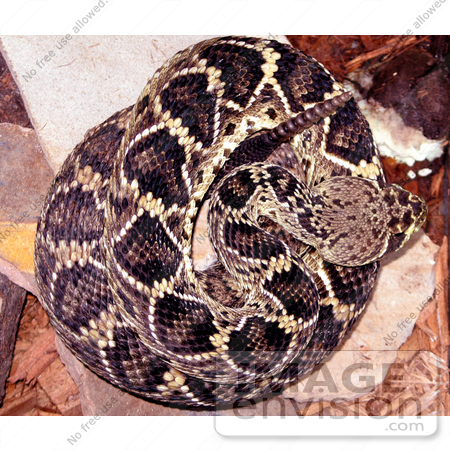

|
Picture of a venomous “Eastern diamondback” rattlesnake, Crotalus adamanteus. Large, gray to olive-colored, it ranges across the southeastern United States, from the coastal lowlands of southeastern North Carolina, southward to the level of the Florida Keys, westward along the Gulf Coast to extreme southeastern Louisiana, placing it in hurricane-prone areas, which is of importance to those living in these regions, and first-responders offering aid to those affected by such a disaster. The dorsal pattern consists of a series prominent white to yellow-edged chocolate to black-colored diamond-shaped markings with light centers that fade somewhat, and fuse into crossbands on the caudal aspect of the body. The tail of this species is often slightly darker than the ground color, and is ringed with black (Tennant 1997). The head bears a conspicuous dark mask, bordered by prominent white lines, that runs diagonally across the cheeks. All but one insular form, Crotalus catalinensis, have the conspicuous distal tail rattle that is composed of loosely attached interlocking buttons of horny keratin. Collision between the narrowly separated inner and outer layers of horny keratin comprising the rattle is responsible for the production of the familiar buzzing sound (Mattison, 1996). It should be noted that the entry of water into the rattle can soften the keratin, and dampen the collision between the opposing layers, even causing the rattle to dislodge, effectively silencing even the loudest of specimens. Because of these factors, and the fact that under many circumstances snakes will “bite first and rattle later”, one should never rely on the common misconception that rattlesnakes will always sound a warning before delivering a bite. It is the only rattlesnake within its range with a “facial mask” that is bordered by two prominent white lines (Connant, 1975). This image was provided by the Centers for Disease Control and Prevention/Edward J. Wozniak D.V.M., Ph.D. . [0003-0702-0313-1442] by 0003
|
Keywords
adobe snake, animal, animals, cdc, crotalus atrox, eastern diamond-backed rattlesnake, eastern diamondback rattlesnake, rattlesnake, rattlesnakes, reptile, reptiles, serpent, serpentes, snake, snakes, venomous rattlesnake species, venomous snake
|
|








